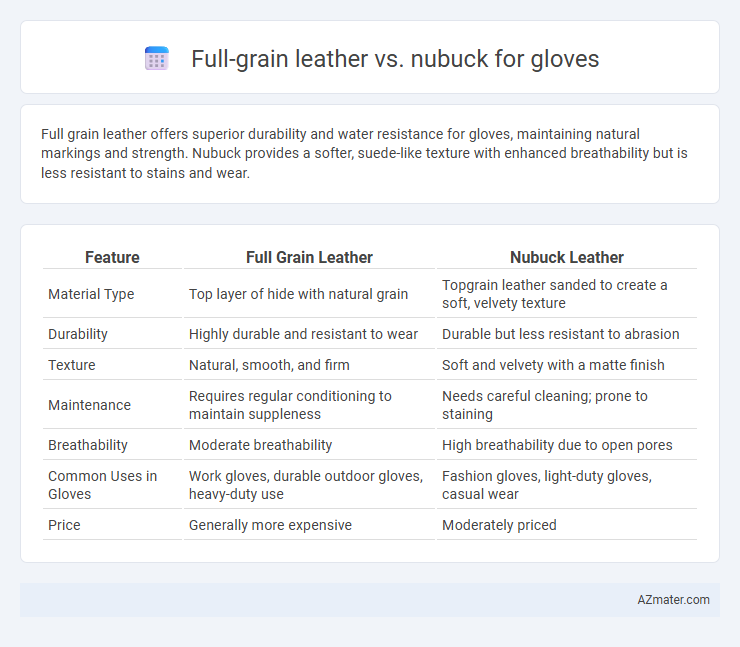Full grain leather offers superior durability and water resistance for gloves, maintaining natural markings and strength. Nubuck provides a softer, suede-like texture with enhanced breathability but is less resistant to stains and wear.
Table of Comparison
| Feature | Full Grain Leather | Nubuck Leather |
|---|---|---|
| Material Type | Top layer of hide with natural grain | Topgrain leather sanded to create a soft, velvety texture |
| Durability | Highly durable and resistant to wear | Durable but less resistant to abrasion |
| Texture | Natural, smooth, and firm | Soft and velvety with a matte finish |
| Maintenance | Requires regular conditioning to maintain suppleness | Needs careful cleaning; prone to staining |
| Breathability | Moderate breathability | High breathability due to open pores |
| Common Uses in Gloves | Work gloves, durable outdoor gloves, heavy-duty use | Fashion gloves, light-duty gloves, casual wear |
| Price | Generally more expensive | Moderately priced |
Overview: Full Grain Leather vs Nubuck
Full grain leather gloves offer superior durability and water resistance due to their intact, natural grain surface, making them ideal for heavy-duty use. Nubuck gloves, sanded on the outer surface to produce a soft, velvety texture, provide enhanced breathability and flexibility but require more delicate care to prevent staining. Both materials excel in comfort and protection, with full grain leather favored for rugged tasks and nubuck preferred for lighter, more precise activities.
What is Full Grain Leather?
Full grain leather, made from the top layer of the hide, retains the natural grain and is known for its durability, breathability, and ability to develop a rich patina over time. This type of leather is less processed than nubuck, preserving its strength and resistance to wear, making it ideal for gloves that require long-lasting protection and comfort. Full grain leather gloves offer superior performance in tough environments due to their toughness and natural texture.
What is Nubuck Leather?
Nubuck leather is a top-grain cattle hide that has been sanded or buffed on the grain side to produce a soft, velvety surface, making it distinct from full grain leather, which retains the natural texture and imperfections of the hide. This sanding process enhances nubuck's aesthetic appeal and softness but also reduces its durability and increases susceptibility to stains compared to full grain leather. For gloves, nubuck offers a plush feel and refined look but requires more maintenance, while full grain leather provides superior strength, longevity, and natural breathability.
Appearance and Texture Comparison
Full grain leather gloves showcase a natural, rugged appearance with visible grain patterns and a firm, durable texture that softens over time. Nubuck gloves feature a velvety, matte finish with a suede-like texture created by sanding the outer grain, offering a softer, more luxurious feel but less resistance to moisture and stains. Both materials provide distinct tactile experiences, with full grain leather emphasizing robustness and nubuck emphasizing smoothness and comfort.
Durability and Strength Differences
Full grain leather gloves offer superior durability and strength due to the intact fiber structure of the hide, making them highly resistant to wear, punctures, and abrasions. Nubuck gloves, while softer and more flexible from the sanding process on the outer surface, are less durable and prone to scratches and staining compared to full grain leather. For long-lasting protection in heavy-duty applications, full grain leather gloves are the optimal choice over nubuck.
Comfort and Flexibility in Gloves
Full grain leather provides superior durability and breathability in gloves, offering excellent comfort by molding to the hand's shape over time while maintaining flexibility. Nubuck leather, sanded on the grain side, delivers a softer, velvety texture that enhances immediate comfort and flexibility but may sacrifice some resistance to wear and moisture. Choosing between the two depends on the glove's intended use, with full grain leather favored for rugged tasks and nubuck preferred for lightweight, supple gloves.
Water and Stain Resistance
Full grain leather gloves offer superior water and stain resistance due to their natural, tightly packed grain surface, which repels moisture more effectively than Nubuck. Nubuck gloves, while softer and more breathable, have a buffed finish that makes them more porous, resulting in lower resistance to water and stains. Applying a specialized waterproofing treatment can enhance the durability of both materials, but full grain leather inherently maintains better protection against environmental elements.
Maintenance and Care Requirements
Full grain leather gloves require regular cleaning with a damp cloth and conditioning with specialized leather conditioners to maintain their durability and waterproof properties. Nubuck gloves, being more delicate due to their sanded surface, need gentle brushing with a nubuck brush and protection sprays to prevent stains and moisture damage. Proper maintenance of both types extends glove lifespan but Nubuck demands more frequent, careful upkeep to preserve its soft texture.
Price and Value Considerations
Full grain leather gloves are typically priced higher due to their durability and natural grain, offering exceptional longevity and resistance to wear. Nubuck gloves, while slightly less expensive, provide a softer texture and aesthetic appeal but may require more maintenance and are less resistant to moisture. Choosing between the two depends on balancing initial cost with long-term value based on intended use and care preferences.
Which Leather is Best for Gloves?
Full grain leather offers superior durability and natural breathability, making it ideal for gloves requiring strong abrasion resistance and long-lasting wear. Nubuck leather provides a soft, velvety texture with excellent flexibility but is less resistant to moisture and stains compared to full grain. For gloves needing maximum toughness and longevity, full grain leather is the best choice, while nubuck suits applications valuing comfort and appearance.

Infographic: Full grain leather vs Nubuck for Glove
 azmater.com
azmater.com